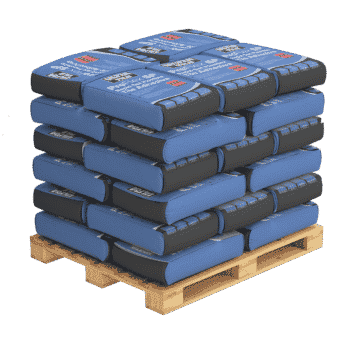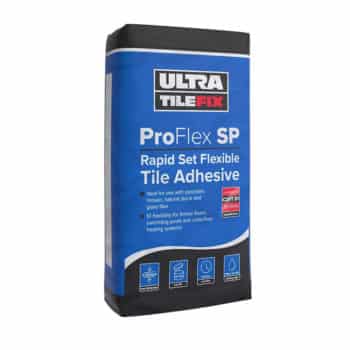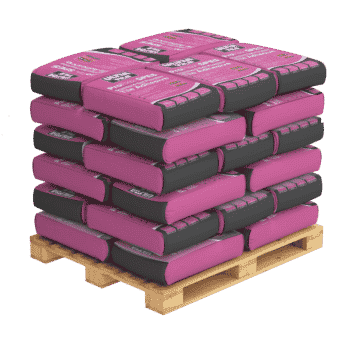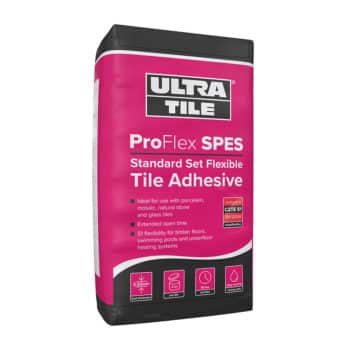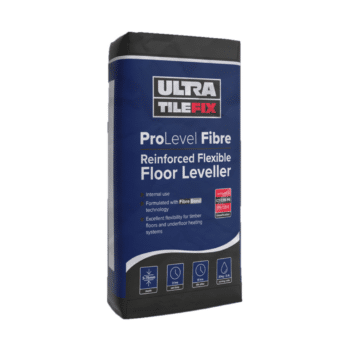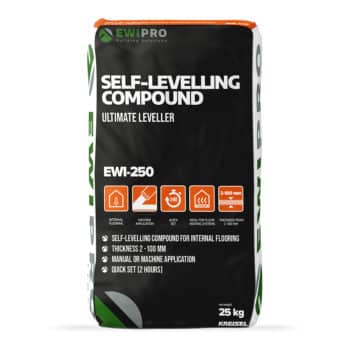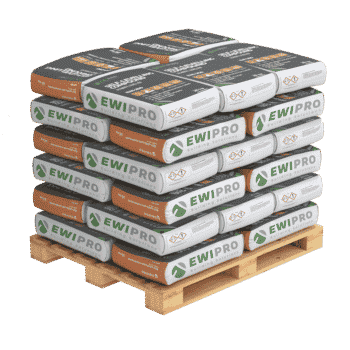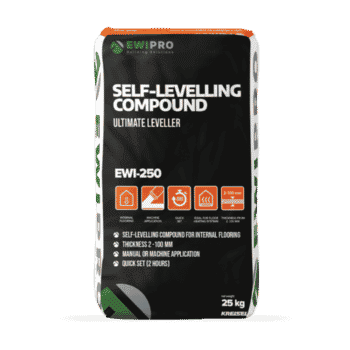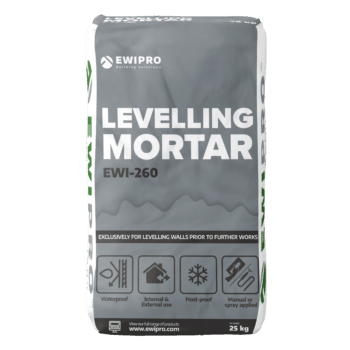Ultimate Guide To Tiling and Levelling
Tiling and levelling work intrinsically together. Whenever you tile an area, you will need the tiles and the substrate to be level. However, levelling can also refer to levelling walls to facilitate the installation of external wall insulation. General floor levelling is also a practice, often associated with underfloor heating. EWI Store continues to expand the range of tiling and levelling products, highlighted by the innovative Clip & Snip system.
What is tiling?
Put simply, tiling is the process of laying tiles. Depending on the application, the tiles are either glazed or unglazed. Internal tiles are glazed and traditionally manufactured from fired clay. However, modern tiles are also made of plastic, glass, or asphalt. Furthermore, fibreboard or other sound-absorbing materials can create acoustical tiles. The tiles can be either functional or decorative, with decorative tiling dating back thousands of years. For example, glass tiles date back to ancient Egypt.
Several tools and products are required for the process of tiling: tile adhesive, trowel, spacers, and tile cutter. At EWI Store, we stock the full range of accompanying tiling and levelling products.
Adhesive
Tile adhesive – Tile adhesive is a type of bonding material that is used to attach tiles to surfaces. It is a cement-based material that is designed to bond tiles to a wide range of substrates, such as concrete, plaster, and wood. Tile adhesive is typically applied to the surface using a trowel, and then the tiles are pressed into place. The adhesive holds the tiles securely in place, preventing them from shifting or slipping over time. Tile adhesive can come in different forms, including powder, paste, or pre-mixed, and it can be used for various types of tiles, including ceramic, porcelain, and natural stone.
We stock ProFlex SPES Tile Adhesive at EWI Store, in standard and rapid set variations. Both products are designed with increased workability, enhanced adhesion, and flexibility. Therefore, the adhesives are suitable for areas where vibration or movement occurs. In most cases, the solid bed method of coverage is advisable.
-
ProFlex SP Tile Adhesive (Rapid Set) 20kg x 50 – White
£828.00 Incl. VAT£690.00 Excl. VAT -
ProFlex SPES Tile Adhesive (Standard Set) 20kg x 50 – White
£793.80 Incl. VAT£661.50 Excl. VAT -
ProFlex SP Tile Adhesive (Rapid Set) 20kg
From £15.30 Incl. VATFrom £12.75 Excl. VAT -
ProFlex SPES Tile Adhesive (Standard Set) 20kg
From £14.27 Incl. VATFrom £11.89 Excl. VAT
Tiling Accessories
Trowel – The best trowel for applying the tiling adhesive is a notched trowel, as internal adhesive beds require ribbing. Regal & Barnes trowels come with notches spaced at a range of intervals; therefore, you can always find the one that matches your requirements. Using a trowel is fairly simple: spread the adhesive in a smooth, even layer, then use the notched edge to create ridges in the adhesive, adjusting the size of the notches based on the tile size and spacing requirements.
Spacers – Spacers come in two variations. Cross-shaped spacers ensure even spacing between floor tiles. However, wedge spacers are used in situations where you are putting bottom cuts above any uneven surface like rough concrete. They can also be used for marble wall tiles where each piece varies slightly and standard spacers will not work.
Tile cutter – A large, hand-operated tool that provides a stable base to cut tiles. The scoring wheel ensures a straight scoring line across the tile. Once scored, the rubber attachment is lowered onto the tile surface and the level is lowered, which snaps the tile gently and precisely.
What is levelling?
Levelling can refer to the process of preparing floors or walls for the installation of certain features, or the levelling of tiles. Ultimately, both are concerned with creating a totally flat surface. This can be achieved with a variety of products.
Levelling walls – To achieve a level surface, whether that be a wall or floor, you will require some form of a cementitious product. Walls will tend to need filling in if they are old, as they may have suffered significant wearing. EWI-260 Levelling Mortar is a great product for this. EWI-260 Levelling Mortar is used on walls as a scratch coat or to prepare an uneven substrate prior to applying render for EWI Pro solid wall insulation systems. The product is a polymer-modified sand and cement mixture, which can be used for repairing and filling cavities in walls.
Levelling floors – Floors require slightly different mortars and are often referred to as floor screeds. For example, our EWI-250 Self-Levelling Compound is specially designed for internal purposes, with a particular focus on a quick set and use in underfloor heating projects. We also stock another floor levelling product. UltraTile ProLevel Fibre Reinforced Flexible Floor Leveller is a single-part, high-strength, rapid drying and curing concrete floor leveller. This floor leveller incorporates a blend of specially graded fillers, cement, polymers and fibres. The specially formulated fibre technology aids application and strength, resulting in a strong and even base which sets in 3 hours and can be tiled after 8 hours.
-
ProLevel Fibre: Reinforced Flexible Floor Leveller – 20kg
£17.53 Incl. VAT£14.61 Excl. VAT -
Self-Levelling Compound, Ultimate Leveller (EWI-250)
Rated 5.00 out of 5£18.52 Incl. VAT£15.43 Excl. VAT£20.58 Incl. VAT£17.15 Excl. VAT -
Self-Levelling Compound, Ultimate Leveller (EWI-250) x 40
Rated 5.00 out of 5£791.04 Incl. VAT£659.20 Excl. VAT -
Levelling Mortar (EWI-260) – 25kg
Rated 4.67 out of 5£13.80 Incl. VAT£11.50 Excl. VAT£14.57 Incl. VAT£12.14 Excl. VAT
https://www.youtube.com/watch?v=CTKBGcIBbdo
Clip & Snip – when tiling and levelling meet
The newest entry into the EWI Store tiling and levelling range is the innovative Clip & Snip system. The system turns into a slow, laborious, and potentially damaging system and turns into a very simple clip-and-snip procedure. Wedge style and screw-in levellers have no presets for how level a surface should be. The removal of these systems also relies on brute force, which exposes fragile tiles to cracking and scratches. However, the Clip & Snip system is designed with precisely these issues in mind. It is incredibly easy to use and does not damage the tiles. The double-notched straps will always break off in the exact same place. The strapping gun speeds up the whole process of tiling, reducing the time required on site. The clips are also durable and reusable, which is often not the case with traditional systems.
Tips for tiling
- Plan ahead: Measure the area you plan to tile, and calculate how many tiles you’ll need. Plan out the layout of the tiles, and make sure to take into account any corners, obstacles, or odd angles.
- Prepare the surface: Make sure the surface you’re tiling is clean, level, and dry. Remove any old tiles and repair any cracks or holes. If necessary, use a primer to help the tiles adhere.
- Choose the right adhesive: Make sure to choose an adhesive that is appropriate for your tiles and your surface. For example, if you’re tiling a bathroom, you’ll want to use a waterproof adhesive.
- Cut tiles carefully: If you need to cut tiles to fit around corners or obstacles, use a tile cutter or a tile saw. Make sure to measure carefully and make precise cuts.
- Use spacers: Spacers will help ensure that your tiles are evenly spaced and aligned. They’ll also help you maintain the proper grout lines.
- Allow for expansion: When tiling in an area that will be exposed to heat or moisture, such as a bathroom or kitchen, make sure to leave a small gap between the tiles to allow for expansion.
- Grout carefully: Once your tiles are in place, use a rubber float to apply grout between the tiles. Be sure to fill all the gaps evenly and wipe away any excess grout.
- Clean up: Once the grout has dried, use a damp sponge to wipe away any remaining grout haze. Allow the tiles to dry completely before using the area.
Tips for levelling
- Assess the surface: Before starting any levelling work, assess the surface you plan to level. Determine the cause of any unevenness, whether it’s due to settling, moisture, or other factors.
- Choose the right material: Choose a levelling compound or mortar that is appropriate for the surface you’re levelling. For example, if you’re levelling a concrete floor, you’ll want to use a self-levelling compound.
- Prepare the surface: Clean the surface thoroughly and remove any loose debris, dirt, or old adhesive. If the surface is very uneven, you may need to use a grinder or chisel to remove high spots.
- Apply the levelling compound: Follow the manufacturer’s instructions to mix and apply the levelling compound. Use a trowel or a flat board to spread the compound evenly over the surface, working in small sections.
- Smooth and level the surface: Use a screed or a long, straight board to level the compound as you apply it. Check the level frequently and make adjustments as necessary.
- Allow the compound to dry: Follow the manufacturer’s instructions for drying time. Once the compound is dry, check the surface for any remaining high spots or unevenness.
- Sand or grind the surface: If necessary, use a sander or grinder to remove any remaining high spots or roughness.
- Finish the surface: Once the surface is level, you can proceed with any necessary finishing work, such as laying tile or painting
Facebook
Twitter
LinkedIn
Your cart
Trade Account Login

We use cookies on our website to give you the most relevant experience by remembering your preferences and repeat visits. By clicking “Accept All”, you consent to the use of ALL the cookies. However, you may visit "Cookie Settings" to provide personalised consent.
Manage consent
Privacy Overview
This website uses cookies to improve your experience while you navigate through the website. Out of these, the cookies that are categorized as necessary are stored on your browser as they are essential for the working of basic functionalities of the website. We also use third-party cookies that help us analyze and understand how you use this website. These cookies will be stored in your browser only with your consent. You also have the option to opt-out of these cookies. But opting out of some of these cookies may affect your browsing experience.
Necessary cookies are absolutely essential for the website to function properly. These cookies ensure basic functionalities and security features of the website, anonymously.
| Cookie | Duration | Description |
|---|---|---|
| __stripe_mid | 1 year | This cookie is set by Stripe payment gateway. This cookie is used to enable payment on the website without storing any patment information on a server. |
| __stripe_sid | 30 minutes | This cookie is set by Stripe payment gateway. This cookie is used to enable payment on the website without storing any patment information on a server. |
| _GRECAPTCHA | 5 months 27 days | This cookie is set by the Google recaptcha service to identify bots to protect the website against malicious spam attacks. |
| apbct_cookies_test | session | CleanTalk sets this cookie to prevent spam on comments and forms and act as a complete anti-spam solution and firewall for the site. |
| apbct_page_hits | session | CleanTalk sets this cookie to prevent spam on comments and forms and act as a complete anti-spam solution and firewall for the site. |
| apbct_prev_referer | session | Functional cookie placed by CleanTalk Spam Protect to store referring IDs and prevent unauthorized spam from being sent from the website. |
| apbct_site_landing_ts | session | CleanTalk sets this cookie to prevent spam on comments and forms and act as a complete anti-spam solution and firewall for the site. |
| apbct_site_referer | 3 days | This cookie is placed by CleanTalk Spam Protect to prevent spam and to store the referrer page address which led the user to the website. |
| apbct_timestamp | session | CleanTalk sets this cookie to prevent spam on comments and forms and act as a complete anti-spam solution and firewall for the site. |
| apbct_urls | 3 days | This cookie is placed by CleanTalk Spam Protect to prevent spam and to store the addresses (urls) visited on the website. |
| AWSALBCORS | 7 days | This cookie is managed by Amazon Web Services and is used for load balancing. |
| cookielawinfo-checkbox-advertisement | 1 year | Set by the GDPR Cookie Consent plugin, this cookie is used to record the user consent for the cookies in the "Advertisement" category . |
| cookielawinfo-checkbox-analytics | 11 months | This cookie is set by GDPR Cookie Consent plugin. The cookie is used to store the user consent for the cookies in the category "Analytics". |
| cookielawinfo-checkbox-functional | 11 months | The cookie is set by GDPR cookie consent to record the user consent for the cookies in the category "Functional". |
| cookielawinfo-checkbox-necessary | 11 months | This cookie is set by GDPR Cookie Consent plugin. The cookies is used to store the user consent for the cookies in the category "Necessary". |
| cookielawinfo-checkbox-others | 11 months | This cookie is set by GDPR Cookie Consent plugin. The cookie is used to store the user consent for the cookies in the category "Other. |
| cookielawinfo-checkbox-performance | 11 months | This cookie is set by GDPR Cookie Consent plugin. The cookie is used to store the user consent for the cookies in the category "Performance". |
| ct_checkjs | session | CleanTalk–Used to prevent spam on our comments and forms and acts as a complete anti-spam solution and firewall for this site. |
| ct_fkp_timestamp | session | CleanTalk sets this cookie to prevent spam on the site's comments/forms, and to act as a complete anti-spam solution and firewall for the site. |
| ct_pointer_data | session | CleanTalk sets this cookie to prevent spam on the site's comments/forms, and to act as a complete anti-spam solution and firewall for the site. |
| ct_ps_timestamp | session | CleanTalk sets this cookie to prevent spam on the site's comments/forms, and to act as a complete anti-spam solution and firewall for the site. |
| ct_sfw_pass_key | 1 month | CleanTalk sets this cookie to prevent spam on comments and forms and act as a complete anti-spam solution and firewall for the site. |
| ct_timezone | session | CleanTalk–Used to prevent spam on our comments and forms and acts as a complete anti-spam solution and firewall for this site. |
| elementor | never | This cookie is used by the website's WordPress theme. It allows the website owner to implement or change the website's content in real-time. |
| viewed_cookie_policy | 11 months | The cookie is set by the GDPR Cookie Consent plugin and is used to store whether or not user has consented to the use of cookies. It does not store any personal data. |
Functional cookies help to perform certain functionalities like sharing the content of the website on social media platforms, collect feedbacks, and other third-party features.
| Cookie | Duration | Description |
|---|---|---|
| __zlcmid | 1 year | This cookie is used by Zendesk live chat and is used to store the live chat ID. |
| bcookie | 2 years | LinkedIn sets this cookie from LinkedIn share buttons and ad tags to recognize browser ID. |
| bscookie | 2 years | LinkedIn sets this cookie to store performed actions on the website. |
| lang | session | LinkedIn sets this cookie to remember a user's language setting. |
| lidc | 1 day | LinkedIn sets the lidc cookie to facilitate data center selection. |
| UserMatchHistory | 1 month | LinkedIn sets this cookie for LinkedIn Ads ID syncing. |
Performance cookies are used to understand and analyze the key performance indexes of the website which helps in delivering a better user experience for the visitors.
| Cookie | Duration | Description |
|---|---|---|
| __utma | 2 years | This cookie is set by Google Analytics and is used to distinguish users and sessions. The cookie is created when the JavaScript library executes and there are no existing __utma cookies. The cookie is updated every time data is sent to Google Analytics. |
| __utmb | 30 minutes | Google Analytics sets this cookie, to determine new sessions/visits. __utmb cookie is created when the JavaScript library executes and there are no existing __utma cookies. It is updated every time data is sent to Google Analytics. |
| __utmc | session | The cookie is set by Google Analytics and is deleted when the user closes the browser. It is used to enable interoperability with urchin.js, which is an older version of Google Analytics and is used in conjunction with the __utmb cookie to determine new sessions/visits. |
| __utmt | 10 minutes | Google Analytics sets this cookie to inhibit request rate. |
| __utmv | 2 years | The __utmv cookie is set on the user's device, to enable Google Analytics to classify the visitor. |
| __utmz | 6 months | Google Analytics sets this cookie to store the traffic source or campaign by which the visitor reached the site. |
| sib_cuid | 6 months | Purechat uses this cookie to send data to purechat.com, to connect visitors to the reservation team and track visitors to stay on portal. |
| SRM_B | 1 year 24 days | Used by Microsoft Advertising as a unique ID for visitors. |
Analytical cookies are used to understand how visitors interact with the website. These cookies help provide information on metrics the number of visitors, bounce rate, traffic source, etc.
| Cookie | Duration | Description |
|---|---|---|
| _ga | 2 years | The _ga cookie, installed by Google Analytics, calculates visitor, session and campaign data and also keeps track of site usage for the site's analytics report. The cookie stores information anonymously and assigns a randomly generated number to recognize unique visitors. |
| _gat_gtag_UA_61069204_2 | 1 minute | Set by Google to distinguish users. |
| _gat_UA-61069204-2 | 1 minute | A variation of the _gat cookie set by Google Analytics and Google Tag Manager to allow website owners to track visitor behaviour and measure site performance. The pattern element in the name contains the unique identity number of the account or website it relates to. |
| _gcl_au | 3 months | Provided by Google Tag Manager to experiment advertisement efficiency of websites using their services. |
| _gid | 1 day | Installed by Google Analytics, _gid cookie stores information on how visitors use a website, while also creating an analytics report of the website's performance. Some of the data that are collected include the number of visitors, their source, and the pages they visit anonymously. |
| _uetsid | 1 day | This cookies are used to collect analytical information about how visitors use the website. This information is used to compile report and improve site. |
| CONSENT | 2 years | YouTube sets this cookie via embedded youtube-videos and registers anonymous statistical data. |
Advertisement cookies are used to provide visitors with relevant ads and marketing campaigns. These cookies track visitors across websites and collect information to provide customized ads.
| Cookie | Duration | Description |
|---|---|---|
| _fbp | 3 months | This cookie is set by Facebook to display advertisements when either on Facebook or on a digital platform powered by Facebook advertising, after visiting the website. |
| ANONCHK | 10 minutes | The ANONCHK cookie, set by Bing, is used to store a user's session ID and also verify the clicks from ads on the Bing search engine. The cookie helps in reporting and personalization as well. |
| fr | 3 months | Facebook sets this cookie to show relevant advertisements to users by tracking user behaviour across the web, on sites that have Facebook pixel or Facebook social plugin. |
| MUID | 1 year 24 days | Bing sets this cookie to recognize unique web browsers visiting Microsoft sites. This cookie is used for advertising, site analytics, and other operations. |
| NID | 6 months | NID cookie, set by Google, is used for advertising purposes; to limit the number of times the user sees an ad, to mute unwanted ads, and to measure the effectiveness of ads. |
| test_cookie | 15 minutes | The test_cookie is set by doubleclick.net and is used to determine if the user's browser supports cookies. |
| uuid | 6 months | MediaMath sets this cookie to avoid the same ads from being shown repeatedly and for relevant advertising. |
| VISITOR_INFO1_LIVE | 5 months 27 days | A cookie set by YouTube to measure bandwidth that determines whether the user gets the new or old player interface. |
| YSC | session | YSC cookie is set by Youtube and is used to track the views of embedded videos on Youtube pages. |
| yt-remote-connected-devices | never | YouTube sets this cookie to store the video preferences of the user using embedded YouTube video. |
| yt-remote-device-id | never | YouTube sets this cookie to store the video preferences of the user using embedded YouTube video. |
| yt.innertube::nextId | never | This cookie, set by YouTube, registers a unique ID to store data on what videos from YouTube the user has seen. |
| yt.innertube::requests | never | This cookie, set by YouTube, registers a unique ID to store data on what videos from YouTube the user has seen. |
Other uncategorized cookies are those that are being analyzed and have not been classified into a category as yet.
| Cookie | Duration | Description |
|---|---|---|
| _clck | 1 year | No description |
| _clsk | 1 day | No description |
| _uetvid | 1 year 24 days | No description available. |
| AnalyticsSyncHistory | 1 month | No description |
| apbct_pixel_url | session | No description |
| apbct_visible_fields_0 | session | No description |
| apbct_visible_fields_1 | session | No description |
| apbct_visible_fields_10 | session | No description |
| apbct_visible_fields_2 | session | No description |
| apbct_visible_fields_3 | session | No description |
| apbct_visible_fields_4 | session | No description |
| apbct_visible_fields_5 | session | No description |
| apbct_visible_fields_6 | session | No description |
| apbct_visible_fields_7 | session | No description |
| apbct_visible_fields_8 | session | No description |
| apbct_visible_fields_9 | session | No description |
| ct_checked_emails | session | No description |
| ct_has_scrolled | session | No description |
| ct_mouse_moved | session | No description |
| ct_screen_info | session | No description |
| ictf_master | never | No description available. |
| li_gc | 2 years | No description |
| m | 2 years | No description available. |
| SM | session | No description available. |
| testinfinitycookie | session | No description |
| woocommerce_show_tax | 7 days | No description available. |
| wp_woocommerce_session_c5ac76b408021294cb56bcc27eddf8a1 | 2 days | No description |


